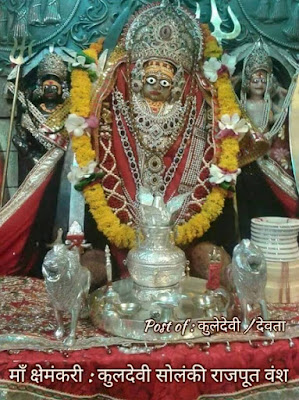Rathore Rajput
Rathore Rajput
 Rājpūt, Rāthor, Rāthaur.—The Rāthor of Jodhpur or Mārwār is one of the most famous clans of Rājpūts, and that which is most widely dominant at the present time, including as it does the Rājas of Jodhpur, Bikaner, Ratlām, Kishengarh and Idar, as well as several smaller states. The
Rājpūt, Rāthor, Rāthaur.—The Rāthor of Jodhpur or Mārwār is one of the most famous clans of Rājpūts, and that which is most widely dominant at the present time, including as it does the Rājas of Jodhpur, Bikaner, Ratlām, Kishengarh and Idar, as well as several smaller states. The
In 1381 Siāhji’s tenth successor, Rao Chonda, took Mundore from a Parihār chief, and made his possession secure by marrying the latter’s daughter. A subsequent [460]chief, Rao Jodha, laid the foundation of Jodhpur in 1459, and transferred thither the seat of government. The site of Jodhpur was selected on a peak known as Joda-gīr, or the hill of strife, four miles distant from Mundore on a crest of the range overlooking the expanse of the desert plains of Mārwār. The position for the new city was chosen at the bidding of a forest ascetic, and was excellently adapted for defence, but had no good water-supply.4 Joda had fourteen sons, of whom the sixth, Bīka, was the founder of the Bikaner state. Rāja Sur Singh (1595–1620) was one of Akbar’s greatest generals, and the emperor Jahāngīr buckled the sword on to his son Gaj Singh with his own hands. Gaj Singh, the next Rāja (1620–1635), was appointed viceroy of the Deccan, as was his successor, Jaswant Singh, under Aurāngzeb. The Mughal Emperors, Colonel Tod remarks, were indebted for half their conquests to the Lākh Tulwār Rāhtorān, the hundred thousand swords which the Rāthors boasted that they could muster.5 On another occasion, when Jahāngīr successfully appealed to the Rājpūts for support against his rebel son Khusru, he was so pleased with the zeal of the Rāthor prince, Rāja Gaj Singh, that he not only took the latter’s hand, but kissed it,6 perhaps an unprecedented honour. But the constant absence from his home on service in distant parts of the empire was so distasteful to Rāja Sur Singh that, when dying in the Deccan, he ordered a pillar to be erected on his grave containing his curse upon any of his race who should cross the Nerbudda. The pomp of imperial greatness or the sunshine of court favour was as nothing with the Rāthor chiefs, Colonel Tod says, when weighed against the exercise of their influence within their own cherished patrimony. The simple fare of the desert was dearer to the Rāthor than all the luxuries of the imperial banquet, which he turned from in disgust to the recollection of the green pulse of Mundore, or his favourite rabi or maize porridge, the prime dish of the Rāthor.7 The Rāthor princes have been not less ready in placing themselves and the forces of their States at the disposal of the British Government, and the latest and perhaps most [461]brilliant example of their loyalty occurred during 1914, when the veteran Sir Partāp Singh of Idar insisted on proceeding to the front against Germany, though over seventy years of age, and was accompanied by his nephew, a boy of sixteen.
The Ratlām State was founded by Ratan Singh, a grandson of Rāja Udai Singh of Jodhpur, who was born about 1618, and obtained it as a grant for good service against the Usbegs at Kandahār and the Persians in Khorasān about 1651–52. Kishangarh was founded by Kishan Singh, a son of the same Rāja Udai Singh, who obtained a grant of territory from Akbar about 1611. Idar State in Gujarāt has, according to its traditions, been held by Rāthor princes from a very early period. Jodhpur State is the largest in Rājputāna, with an area of 35,000 square miles, and a population of two million. The Mahārāja is entitled to a salute of twenty-one guns. A great part of the State is a sandy desert, and its older name of Mārwār is, according to Colonel Tod, a corruption of Mārusthān, or the region of death. In the Central Provinces the Rāthor Rājpūts number about 6000 persons, and are found mainly in the Saugor, Jubbulpore, Narsinghpur and Hoshangābād Districts. The census statistics include about 5000 persons enumerated in Mandla and Bilaspur, nearly all of whom are really Rāthor Telis.







